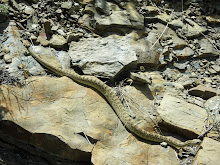A recent paper in Science (Milly et al., 2008, Science v.319, 1 Feb) suggests that one of the sacred cows of modern geomorphology, the concept of stationarity, may be dead. Stationarity is the idea that natural systems, such as rivers, fluctuate around a mean value within a well defined and stationary envelope of variability. It is this concept that allows fluvial geomorphologists to take an instrumental record and establish a probability density function for various magnitudes and frequencies of events, such as peak floods.
Milly et al. (2008) however identify anthropogenic disturbances to drainage basins, channels, floodplains, and watsersheds as having effectively destroyed to stationarity concept at the local scale, while anthropogenic climate change has changed the concept at the global scale by altering long term precipitation patterns.
In fact, the authors question whether stationarity ever existed in observed systems, due to land-use changes that have been in place for hundreds of years and which have shown severe effects on the fluvial systems. The pict
 ure at left is from Providence Canyon, GA, and shows around 150 m of erosion that occured post 1850 due to poor agricultural processes. Clearly, humans can and have had a strong impact on natural systems. All this has considerable impact on planning and policy-making, which are founded on stationarity models for prediction of flood frequency and water availability.
ure at left is from Providence Canyon, GA, and shows around 150 m of erosion that occured post 1850 due to poor agricultural processes. Clearly, humans can and have had a strong impact on natural systems. All this has considerable impact on planning and policy-making, which are founded on stationarity models for prediction of flood frequency and water availability.How does this effect sedimentological facies models? Fluvial facies models are predicated upon the concept that the river system is striving to achieve some equilibrium state, with minor perturbations from the mean being accommodated within the system via feed-back loops and channel evolution. Thus, the very concept of the meandering, braided, and anastomosed river channel planform, which (unfortunately) are the basis for our sedimentological facies models, have the concept of stationarity built-in.
If natural systems, observed at the geomorphic scale, behave in a non-stationary way, then how appropriate are these models for developing interpretations at the stratigraphic scale? In some ways, we should expect the preserved record of fluvial processes to represent only non-stationary systems, since the preservation itself implies the system has been perturbed (by subsidence, or increased sedimentation) beyond the capacity of the channel-system to transport its load. Maybe our facies concepts have given us conceptual models that have made us interpret processes in a completely unrealistic fashion?




1 comment:
I think you have a real point here. Our evaluations of stratigraphic successions are essentially conditional statements. "The cause of X given that X is preserved."
The conditional statement for "process oriented" sedimentological studies in modern systems never takes that same form.
Post a Comment